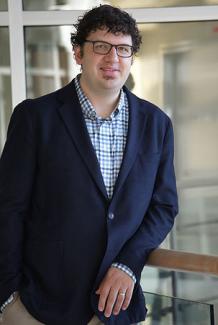Event
Inorganic Chemistry Seminar: Dr. John Swierk
Title: "The obvious facts and deceptions of photoredox reactions"

Dr. John Swierk
Binghamton University
jswierk@binghamton.edu
Abstract
-Photoredox catalysis is transforming modern synthetic chemistry. Expensive, hard to handle stoichiometric reagents can be replaced by short-lived excited states using a visible light absorbing photocatalyst. While the scope of photoredox methods has grown at an exceptional pace, mechanistic and kinetic understanding has lagged behind. An overarching goal of research in the Swierk group is to provide a solid mechanistic foundation for reactions that are successful but poorly understood. This talk will describe how a combination of transient absorption spectroscopy, electrochemical methods, steady state photochemical measurements, and kinetic modeling can be used to map out the reaction mechanisms and kinetics of photoredox reactions, using prototypical examples involving cyanoarene coupling partners. In addition, the unexpected roles that cyanoarenes play in these reactions will be discussed. Finally, the talk will discuss how factors unrelated to the kinetics of the coupling reaction can serve to limit efficiency in photoredox reactions.
Background
"The Swierk group is broadly interested in understanding and controlling radical reactions initiated by single electron transfer, most often via photo- or electrochemistry. Use of spectroscopic and electroanalytical methods are central to much of the research in the group.
One major area of emphasis within the group deals with understanding photoredox reactions. This class of reactions is transforming modern synthetic chemistry by substituting hard to handle, expensive, and toxic reagents (e.g., HSnBu3) with short-lived excited states that can themselves be potent oxidants or reductants. Challenging bond forming reactions can be accessed with this chemistry and often a variety of functional groups can be tolerated. Despite the promise of photoredox methods, a mechanistic understanding is lacking. Using a variety of experimental approaches and kinetic modeling, the Swierk group seeks to completely characterize photoredox catalytic cycles and identify the kinetically-limiting steps, with an eye towards informing the design of new reactions.
A second area of emphasis deals with electrosynthetic reactions and seeks to understand the role of electrode materials and double layer structure on novel, bond-forming reactions intiated electrochemically. Systems of interest range from desulfurization of fuel oils to small molecules for pharmaceutical applications. Standard electrochemical methods (e.g., CV, LSV, impedance) are partnered with the development of new spectroelectrochemical methods.
There is also an NIH-funded effort in the lab focused on the safety and photochemistry of tattoo inks. Despite the popularity of tattoos and the billions of dollars spent every year on laser tattoo removal, we do not understand how tattoo inks transform under illumination and what risks that may pose to human health. The Swierk group utilizes a transdisciplinary approach that draws from analytical chemistry, materials science, and cell biology to address the simple question "How do tattoos fade?"
In addition to the major project areas described above, there is also work in the group on the synthesis of carborane transition metal complexes for photophysical and catalytic applications, deep eutectic solvents for organic reactions, and photoelectrochemical methods for initiating radical reaction mechanisms"
Johnswierk.com
https://www.binghamton.edu/chemistry/faculty/profile.html?id=jswierk
HOST: Mallouk
